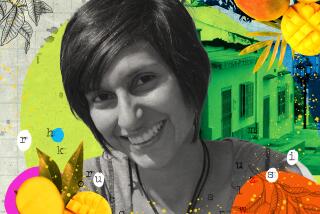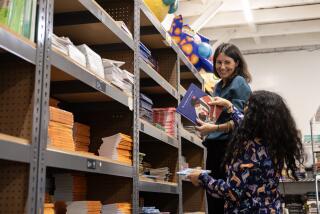Illiteracy Dogs Remote Dominican Village
LOS MARRANITOS, Dominican Republic — The teacher produces her test, a handwritten alphabet, and the student leans toward the paper, straining to identify the letters.
When the pen stops at K, Javier Moronta is unsure: “Q?” he asks. At S, he first says “C,” then corrects himself.
Moronta is 22, and he is learning to read from children’s books. Here in the mountain village of Los Marranitos, life revolves around growing coffee, and illiteracy is the norm.
It’s a persistent problem in the Dominican Republic, a nation of 8.5 million people where nearly one of every five adults cannot read and write. As in many poor countries, remedies often face resistance, particularly among poor families that see little need for learning to read.
“My biggest challenge has been trying to get people to come to class,” says Laura Marlow, a 22-year-old volunteer teacher from the U.S.
Lots of Blame to Go Around
Teachers and government officials say poverty is a principal cause of illiteracy, but they also blame inadequate schools, misguided policies and social attitudes that put little value on education.
Most adults in Los Marranitos know how to pick coffee but only a third can read, some at only the most basic level. When they vote, they mark symbols that represent each party: a rooster, a torch, a star. Even the 60-year-old mayor can’t read.
There are no newspapers in the mountains 80 miles northwest of Santo Domingo, the capital. Although the people here live in the middle of an island, most have never seen the sea.
Marlow goes door-to-door urging parents to send children to her class. “So many parents here still see school as absolutely useless,” she says. “They see it as a waste of time.”
Some see classes as taking away a needed pair of hands. Some children skip school to wash clothes or baby-sit. Others never go. When they hit their teens, many drop out to help support relatives.
One afternoon, Marlow rounds up two dozen children in this community of 125 people as she walks the dirt road. Some elude her, darting past playing tag and giggling. Others say they have chores. “I have to clean up,” says a bashful 7-year-old girl, turning into the gate of a simple wooden home.
Moronta, one of Marlow’s few adult students, is an exception who hopes that learning to read and write will help him find work in Spain, the former colonial power, or in the United States.
“I see that if someone knows how to read, life becomes easier,” says Moronta, who works odd jobs.
Volunteer Teacher Is College Graduate
Marlow came as a volunteer after graduating from Middlebury College in Vermont, where she studied Spanish. The Global Education Fund of Boulder, Colo., helps support her.
She learned of the job through author Julia Alvarez, a writer-in-residence at the college who owns an organic coffee farm in Los Marranitos with her husband, Bill Eichner. They call it Alta Gracia, or High Grace.
“My idea was that once the farm really got going, we would use the proceeds to fund an arts center,” Alvarez says. “Then I realized most of the people around there didn’t even know how to read or write. . . . We decided first things first.”
They began collecting donated books and putting them on shelves in a shed that serves as a library.
They are needed for the 6-, 7- and 8-year-olds who attend morning class in the farm’s one-room school because, while the government provides bread and milk each day, it sends no books. Teacher Bolivar Abreu, who earns $300 a month, says his students still don’t know the whole alphabet, “because we’re going letter by letter.”
That may be because class lasts as little as 2 1/2 hours.
At a larger school in nearby Los Dajaos, there is a 17-year-old boy in third grade. He still can’t read.
Few students do homework and few make it to eighth grade, says head teacher Miriam Bonifacio, who struggles to teach 160 students with two other teachers and little parental support.
“We feel like we’re working alone,” she says. “So many years here, and they’re always behind.”
According to the most recent U.N. estimates, 16.8% of Dominicans 15 and older were illiterate in 1999.
The problem is much worse in neighboring Haiti, which shares the island of Hispaniola with the Dominican Republic. With about 52% illiterate, Haiti’s government has opened thousands of centers to teach adults to read Creole, with the ambitious goal of reducing illiteracy to 25% by 2004.
Some countries in the region have all but wiped out the problem: Costa Rica has 4.5% illiteracy, Barbados only 3%.
After Fidel Castro’s 1959 communist revolution, Cuba mobilized nearly 270,000 volunteers in a campaign that reduced illiteracy from 23% to 3%.
A Demonstrated Need to Read
The Dominican government now pays small fees to leaders of adult classes. About 100,000 are enrolled and thousands have learned to read, says Midalma Lopez, head of the country’s adult education directorate.
On Alta Gracia, illiterate coffee workers ask a self-taught co-worker to write their letters to lovers and friends. The farm’s caretaker, Miguel Antonio Placencia, has a friend write his work reports.
But Placencia and his wife, Carmen Abreu, are studying with Madrelle Cartwright, a Peace Corps volunteer from Makawao, Hawaii, who lives up the hill. Three of their four children have learned to read.
“I want them to learn so they don’t have to live like their father, working with a machete,” Abreu says.
Alvarez wrote about Abreu’s family in her book “A Cafecito Story,” a fable about coffee, reading and organic farming. By the happy end, “Miguel and Carmen and their children can read a whole book.”
More to Read
Sign up for Essential California
The most important California stories and recommendations in your inbox every morning.
You may occasionally receive promotional content from the Los Angeles Times.










